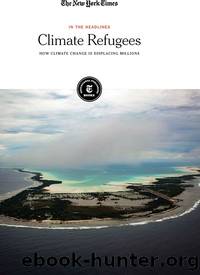Climate Refugees by The New York Times Editorial Staff

Author:The New York Times Editorial Staff
Language: eng
Format: epub
Publisher: The Rosen Publishing Group, Inc
CHAPTER 3
Forced Migration
Climate change causes conditions that drive people from their homes, forcing them to seek safer or more sustainable places to live. Due to rising sea levels, water scarcity and the inability to grow enough food, climate refugees across the world are growing in numbers. Even so, there are still those who wonder if climate change is a real phenomenon, while others consider how a warmer planet is driving human migration.
Climate Change Claims a Lake, and an Identity
BY NICHOLAS CASEY | JULY 7, 2016
LLAPALLAPANI, BOLIVIA â The water receded and the fish died. They surfaced by the tens of thousands, belly-up, and the stench drifted in the air for weeks.
The birds that had fed on the fish had little choice but to abandon Lake Poopó, once Boliviaâs second-largest but now just a dry, salty expanse. Many of the Uru-Murato people, who had lived off its waters for generations, left as well, joining a new global march of refugees fleeing not war or persecution, but climate change.
âThe lake was our mother and our father,â said Adrián Quispe, one of five brothers who were working as fishermen and raising families here in Llapallapani. âWithout this lake, where do we go?â
After surviving decades of water diversion and cyclical El Niño droughts in the Andes, Lake Poopó basically disappeared in December. The ripple effects go beyond the loss of livelihood for the Quispes and hundreds of other fishing families, beyond the migration of people forced to leave homes that are no longer viable.
The vanishing of Lake Poopó threatens the very identity of the Uru-Murato people, the oldest indigenous group in the area. They adapted over generations to the conquests of the Inca and the Spanish, but seem unable to adjust to the abrupt upheaval climate change has caused.
Only 636 Uru-Murato are estimated to remain in Llapallapani and two nearby villages. Since the fish died off in 2014, scores have left to work in lead mines or salt flats up to 200 miles away; those who stayed behind scrape by as farmers or otherwise survive on what used to be the shore.
Emilio Huanaco, an indigenous judicial official, is down to his last bottles of flamingo fat, used for centuries to alleviate arthritis. He has never used medication for his aching knee.
Eva Choque, 33, sat next to her adobe home drying meat for the first time on a clothesline. She and her four children ate only fish before.
They and their neighbors were known to nearly everyone in the area as âthe people of the lake.â Some adopted the last name Mauricio after the mauri, which is what they called a fish that used to fill their nets. They worshiped St. Peter because he was a fisherman, ritually offering him fish each September at the waterâs edge, but that celebration ended when the fish died two years ago.
âThis is a millenarian culture that has been here since the start,â said Carol Rocha Grimaldi, a Bolivian anthropologist whose office shows a satellite picture of a full lake, a scene no longer visible in real life.
Download
This site does not store any files on its server. We only index and link to content provided by other sites. Please contact the content providers to delete copyright contents if any and email us, we'll remove relevant links or contents immediately.
Harry Potter: A Journey Through a History of Magic by British Library(380)
The Science of Philip Pullman's His Dark Materials by Mary Gribbin(362)
The Basics of Organic Chemistry by Clowes Martin;(353)
Harry Potter and the Sorcerer's Stone: SparkNotes Literature Guide by SparkNotes(319)
Flowers in the Gutter by K. R. Gaddy(288)
Braiding Sweetgrass for Young Adults by Robin Wall Kimmerer(284)
Super Simple Chemistry by D.K. Publishing(280)
Summary of the Selfish Gene by Readtrepreneur Publishing(278)
JavaScript Coding for Teens: A Beginner's Guide to Developing Websites and Games by Yueh Andrew(275)
Exam Success in Geography for IGCSE & O Level by Unknown(270)
Dark days in Salem: the witchcraft trials by Deborah Kent(258)
The Python Audio Cookbook;Recipes for Audio Scripting with Python by Alexandros Drymonitis(257)
Key Immigration Laws by Kathryn Ohnaka(247)
Analysis and Linear Algebra for Finance: Part II by Bookboon.com(247)
Cracking the AP Economics Macro & Micro Exams, 2017 Edition by Princeton Review(238)
Solutions for a Cleaner, Greener Planet: Environmental Chemistry by Marc Zimmer(233)
The Science of Fashion by Julie Danneberg;(225)
Reverse Engineering For Everyone! by mytechnotalent(223)
Cracking the AP Psychology Exam, 2017 Edition by Princeton Review(212)
